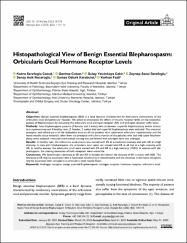| dc.contributor.author | Cabuk, Kubra Serefoglu | |
| dc.contributor.author | Coban, Ganime | |
| dc.contributor.author | Cakir, Gulay Yalcinkaya | |
| dc.contributor.author | Serefoglu, Zeynep Sezal | |
| dc.contributor.author | Nacaroglu, Senay Asik | |
| dc.contributor.author | Karabulut, Gamze Ozturk | |
| dc.contributor.author | Fazil, Korhan | |
| dc.date.accessioned | 2023-07-31T08:02:30Z | |
| dc.date.available | 2023-07-31T08:02:30Z | |
| dc.date.issued | 2023 | en_US |
| dc.identifier.citation | Şerefoğlu Çabuk, K., Çoban, G., Yalçınkaya Çakır, G., Sezal Şerefoğlu, Z., Aşık Nacaroğlu, Ş., Öztürk Karabulut, G., & Fazıl, K. (2023). Histopathological view of benign essential blepharospasm: Orbicularis oculi hormone receptor levels. Beyoglu Eye Journal. | en_US |
| dc.identifier.issn | 2459-1777 | |
| dc.identifier.uri | https://doi.org/10.14744/bej.2023.16779 | |
| dc.identifier.uri | https://hdl.handle.net/20.500.12294/3925 | |
| dc.description.abstract | Objectives: Benign essential blepharospasm (BEB) is a focal dystonia characterized by involuntary contractions of the orbicularis oculi and periocular muscles. We aimed to investigate the effects of muscle receptor levels on the etiopathogenesis of blepharospasm by evaluating the orbicularis oculi estrogen receptor (ER) and androgen receptor (AR) levels. Methods: Four blepharospasm patients (2 females and 2 males) who underwent upper lid blepharoplasty and/or orbicularis myomectomy and 4 healthy cases (2 females, 2 males) that had upper lid blepharoplasty were included. The pretarsal, preseptal, and orbital parts of the orbicularis muscles of the patients who underwent orbicularis myomectomy and the waste muscle tissue materials taken from the preseptal orbicularis muscles of the patients who had only upper blepharoplasty were analyzed. Immunohistochemical staining was performed with estrogen alpha and androgen. Results: In healthy men, the orbicularis oculi muscle was stained with ER at a moderate intensity and with AR at a high intensity. In men with blepharospasm, the orbicularis oculi were not stained with ER at all, but at a high intensity with AR. In healthy women, the orbicularis oculi were stained with ER and AR at a high intensity (>50%). In women with blepharospasm, the staining intensities of both receptors were moderate. Conclusion: We determined a decrease in ER and AR in females and almost the absence of ER in males with BEB. This decrease in ER may be associated with a functional abnormality in mitochondria and the decrease in hormonal receptors may be associated with sarcopenia in orbicularis oculi muscle fibers. © 2023 Israel Medical Association Journal. | en_US |
| dc.language.iso | eng | en_US |
| dc.publisher | Kare Publishing | en_US |
| dc.relation.ispartof | Beyoglu Eye Journal | en_US |
| dc.identifier.doi | 10.14744/bej.2023.16779 | en_US |
| dc.rights | info:eu-repo/semantics/openAccess | en_US |
| dc.subject | Androgen receptor | en_US |
| dc.subject | benign essential blepharospasm | en_US |
| dc.subject | estrogen receptor | en_US |
| dc.subject | hormone receptor | en_US |
| dc.subject | orbicularis oculi | en_US |
| dc.title | Histopathological View of Benign Essential Blepharospasm: Orbicularis Oculi Hormone Receptor Levels | en_US |
| dc.type | article | en_US |
| dc.department | Tıp Fakültesi, Dahili Tıp Bölümü | en_US |
| dc.authorid | 0000-0003-0403-9749 | en_US |
| dc.identifier.volume | 8 | en_US |
| dc.identifier.issue | 2 | en_US |
| dc.identifier.startpage | 110 | en_US |
| dc.identifier.endpage | 114 | en_US |
| dc.relation.publicationcategory | Makale - Uluslararası Hakemli Dergi - Kurum Öğretim Elemanı | en_US |
| dc.institutionauthor | Karabulut, Gamze Ozturk | |
| dc.authorscopusid | 56180319800 | en_US |
| dc.identifier.scopus | 2-s2.0-85162165372 | en_US |


















